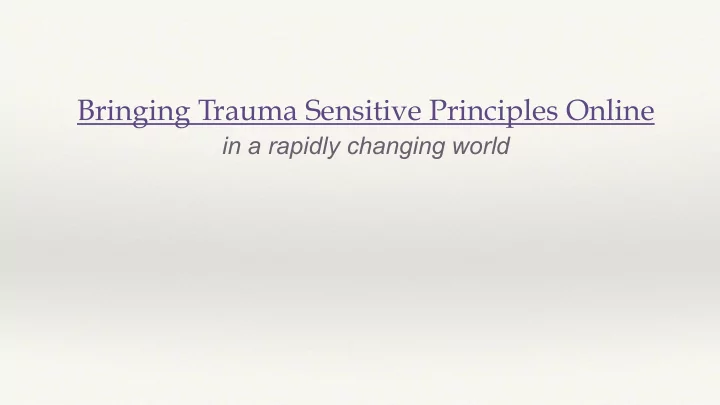

Bringing Trauma Sensitive Principles Online in a rapidly changing world
Why Trauma - Why Now? • Relational, intergeneration and systemic trauma impacts our students • These impacts are compounded by COVID, systemic racism, brutality and the loss of agency that many of us are experiencing • Yoga, as delivered in the mainstream prioritizes the experiences of white, able bodied, cis gendered and privileged folx. We can do better.
Who is Jenn? • Trained in Kripalu Yoga • Studied counseling/psychology at Lesley University • Teaches ongoing TCTSY sessions • NIH Research study • Leads trainings throughout the U.S on integrating body into trauma treatment • Currently in private practice integrating body-trauma • Co-founder and co-director at the Center for Trauma and Embodiment @JRI
Core Principles of Trauma Sensitive Yoga Practice • Invitation • Choices • Present Moment Experience • Non-coercion • Shared Authentic Experience
Invitation • We use invitational language to create an environment of consent and collaboration • Through the tool of invitational language we immediately communicate our intention and practice of power sharing. • In the context of yoga, invitational language offers us opportunities as practitioners and participants, to opt out, adjust pace or listen to our internal needs.
Choices • At the core of trauma is a fundamental loss of choice, as Judith Herman illuminates. • Part of recovery is reclaiming choice and agency. • Many relationships and practices that aim to be healing, actually perpetuate loss of agency and opportunities for choice making.
Invitation and choices online • Continue the language of invitation and choices • Choices about: when to leave when to stay • how to participate and when to opt out or make other choices • choices about saying hello via chat/ video or not • Be clear about when you aren’t offering choices…..and why
Present moment- interoception • Trauma pulls us into conditions of the past, not just in our minds but in our bodies. • Our capacity to feel safe, present and grounded in the present is significantly impacted trauma. It’s not just the idea of not being present, it’s the felt experience. • Providing opportunities to bring awareness and sensation the the present moment creates experiences that are not trauma.
Non-coercion • Another hallmark of trauma is when someone enacts their will over another, through physical or emotional force, or through deprivation. • In the healing of trauma creating relationships and environments where survivors are supported in re-discovering their own empowerment and voice are paramount. • Survivors must be supported in becoming the arbiters of their own healing, which means as providers we must examine our own expectations.
Interoception and non-coercion online • Create opportunities for interoception by muting and turning off video of all participants (and being transparent about why) • Explore how much interoception is appropriate if we don’t have as much scaffolding • Continue to not have an expectation of increased peace or relaxation when we are asking folks to turn toward their felt experience, particularly during this time
Shared Authentic Experience • Experiences of trauma that occur when there is an imbalance of power; in intimate relationships, communities and the systems we are beholden to. • Often survivors seek care in systems where there is an imbalance of power between provider and those seeking help. • We look to equalize this imbalance by showing up in the room and having shared experience with participants. We explore together, and share in this exploration.
Shared Authentic experience = creating community • we STILL practice with participants • Ask for input about how sessions are going, and provide multiple avenues for feedback (surveys, email, direct feedback) • Let folks know how you are showing up and how much time you have to give after a session to chat or say hello- hold the frame • The beauty of facilitating is that we are holding a space
bonus…… predictability • The familiar sequence of forms or the sound of a teachers voice can be an ANCHOR when we are mid-trauma. We don’t need to manufacture difficulty- this time is already difficult. • Online platforms may be new to folks, and leave participants feeling flustered- clear directions in documents/pdfs that can be saved to devices are best to serve as a reference. • When you can use the same link for a meeting to cut out extra steps • What is the environment that you are in? Consider lighting/background and noise as possible triggers to eliminate. • It makes a difference who is facilitating- if there is someone subbing- let participants know so they have the choice of opting in or out prior to when its starts.
Questions?
Ongoing connection www.jenn-turner.com www.traumasensitiveyoga.com Instagram: @tctsy Facebook: Center for Trauma and Embodiment
Recommend
More recommend